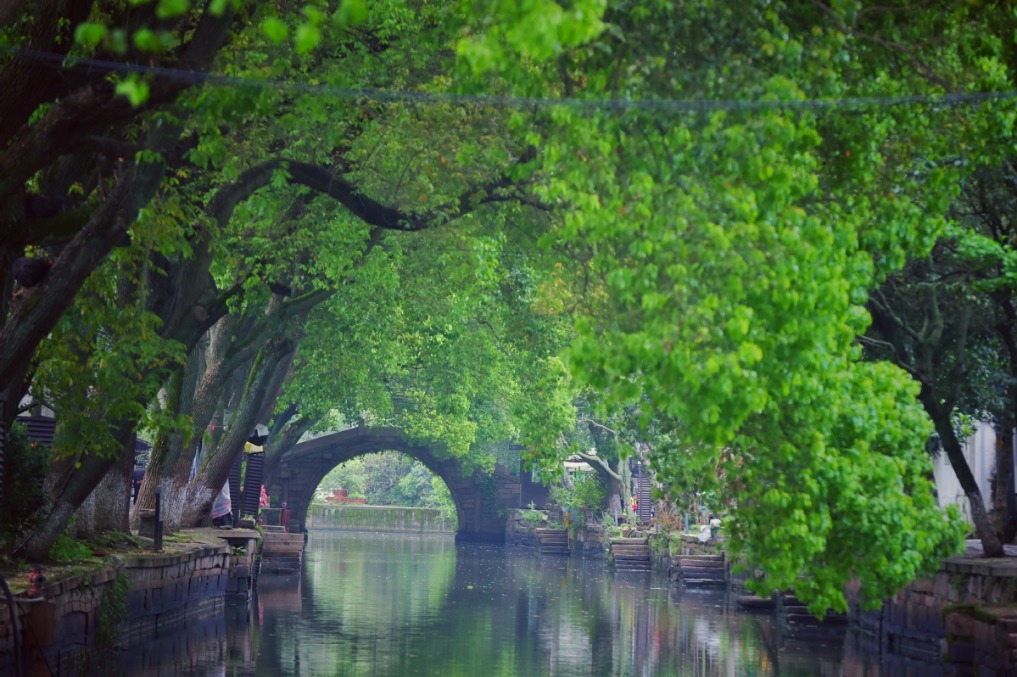Gentrification of Beijing’s hutongs 北京胡同改造
中国日报网 2019-05-28 10:51

Reader question:
Please explain “gentrification”, as in “gentrification of Beijing’s hutongs.”
My comments:
Hutongs, first of all, are narrow alleys with traditional quadrangular courtyards lined up on both sides. Hutongs are synonymous with old streets with old houses.
Hutongs are quintessential Beijing. Or they used to be.
Gentrification, on the other hand, is a Western word for an upgrade or renovation. In China, we talk about renovation of old neighbourhoods. In the West, people talk about gentrification of old communities.
They mean the same thing.
More or less.
Taken at face value, renovation of an old neighbourhood suggests, for example, streets will be widened and repaved, that old houses may be torn down, that new buildings will be erected, that old residents will be able to move in to new dwellings on old grounds.
Gentrification, however, implies that, for one thing, old residents may not be able to return to their old residences – unless they’re rich enough.
Now, let me explain.
Gentrification, you see, has its root in gentry, or gent, as in ladies and gents. The gentry as a class refer to the aristocracy or the wealthy. Again, this is a Western concept. Anyway, gentrification literally refers to measures and efforts to gentrify, i.e. to literally make people more gentlemen or lady like.
How has this got anything to do with renovation of hutongs.
Let me explain. Today, whenever old buildings in hutongs are torn down, they are replaced with high-rise apartment buildings furnished with modern service facilities such as, say, a shopping mall instead of penny grocery stores of yore. Needless to say, with high-rise apartments, prices for these new houses rise high.
So high, as a matter of fact, that old residents of the neighbourhood won’t be able to afford them. They’re priced out. They usually move to cheaper remote suburbs – to Tiantongyuan, Huilongguan, Tongzhou or Fangshan or localities farther away.
This doesn’t matter as the expensive new houses will be bought by the nouveau riche, the new rich, upstarts including the so-called middle class.
These people are supposed to be more gentleman and lady like – again, pardon me for reading it literally – than old residents who are either uneducated or undereducated.
Supposedly so, at any rate.
That’s the gentrification process, in a nutshell.
In the West, gentrification means exactly the same, replacing lower-class populations with more educated, richer, middle class citizens.
More or less, as I said.
And here are a few media examples to give you a better idea of the gentrification process, for better or worse:
1. Flag Wars tells the story of what happened to the Olde Towne East community in Columbus, Ohio when the neighborhood went through the process of gentrification in the mid-to-late 1990s. For much of the twentieth century, urbanists, policymakers, and activists were preoccupied with inner city decline across the United States, as people with money and options fled cities for the suburbs. But widespread reports of the American city's demise proved premature. Beginning in the 1970s, urban life slowly began to regain prestige, particularly among artists and the highly educated. By the turn of this century, many cities were thriving again, and their desirability among the wealthy and upwardly mobile was putting intense pressure on rents, real estate prices, and low-income communities.
What is Gentrification?
Gentrification is a general term for the arrival of wealthier people in an existing urban district, a related increase in rents and property values, and changes in the district's character and culture. The term is often used negatively, suggesting the displacement of poor communities by rich outsiders. But the effects of gentrification are complex and contradictory, and its real impact varies.
Many aspects of the gentrification process are desirable. Who wouldn't want to see reduced crime, new investment in buildings and infrastructure, and increased economic activity in their neighborhoods? Unfortunately, the benefits of these changes are often enjoyed disproportionately by the new arrivals, while the established residents find themselves economically and socially marginalized.
Gentrification has been the cause of painful conflict in many American cities, often along racial and economic fault lines. Neighborhood change is often viewed as a miscarriage of social justice, in which wealthy, usually white, newcomers are congratulated for “improving” a neighborhood whose poor, minority residents are displaced by skyrocketing rents and economic change.
- What is Gentrification? POV.org, June 17, 2003.
2. Black burial sites are struggling for survival. Such struggles should be interpreted as elemental battles over the meaning, matter, and worth of black life, history, and memory. Take the Boyd Carter cemetery in Jefferson county, West Virginia, a historic African American burial ground that’s been active since 1902. In early April 2019, the West Virginia Department of Environmental Protection approved a permit for a natural gas pipeline extension to be placed within feet of the historic cemetery. If built, the pipeline would transport gas to a planned heavy manufacturing facility roughly a quarter-mile to the east.
In conjunction with the pipeline’s projected path, the state’s department of transportation has privately expressed its intentions to widen the road adjacent to the cemetery to transport heavy machinery to the industrial plant. Any road widening would most certainly disrupt bodies at rest.
With increasing frequency, it seems, local activists around the country are fighting to preserve historic African American cemeteries from destruction, desecration, and erasure by a rising tide of residential gentrification, heavy industry, and infrastructure development.
Whereas most commentary on gentrification underscores the problem of residential displacement, Boyd Carter descendants want to ensure that the ongoing dislocation of black burial sites is added to that conversation. Historic African American cemeteries often represent the last gasp of a rich history, a history that is often scarcely recorded elsewhere. If black lives are to matter in life, then they also must matter after life.
In just the last year, community leaders from Virginia to Florida, from Pennsylvania to Connecticut – and now West Virginia – have been engaged in several publicized struggles to ensure that such sacred sites are rightfully preserved. Insofar as the history of race has always been a history of access to space, African American cemeteries have served an important community function.
“Since the early 20th-century,” notes Brian Ross, a descendant living nearby, “Boyd Carter was known as a black cemetery in Jefferson county. You didn’t have to buy a plot here. You didn’t have to fight for space here. There was always room for you. But this fight today, this is a fight for racial justice.”
“Listen,” he says as he draws back a breath, “a cemetery with people of any nationality shouldn’t be touched. People wouldn’t attempt to build a highway or a pipeline through Arlington National Cemetery, right? That would be shut down real quick. So why here? Why this historic African American cemetery?”
- Gentrification is erasing black cemeteries and, with it, black history, TheGuardian.com, April 27, 2019.
3. In 2008, the housing market in the United States plummeted. A build up in subprime real estate loans caused the worst economic period in the United States since the Great Depression.
When the economy began to rebound in 2010, people felt relief and for the first time, in a long time, investment in real estate, industry and technology skyrocketed across the nation.
While the economic boom was welcomed with open arms, the recession’s closing created a new conundrum: gentrification. Defined as the displacement of people from neighborhoods within a city, generally poorer residents, gentrification is accompanied by an influx of middle-class or affluent people and a dramatic rise in real estate prices and improved neighborhood amenities, a trend that has swept the nation, particularly in Midtown Atlanta, where Grady is located.
Lauren Welsh is a founder of the Atlanta-based advocacy group ThreadATL, which aims to influence policy around city planning and design decisions. Gentrification breaks up communities, she said.
“Generally, gentrification means the displacement of people,” Welsh said. “When improvements happen in an area, and property values increase, it ultimately displaces people who can’t afford to live there anymore. What is happening across the country is there is more of a trend to move into urban areas. People are moving into cities … People are not moving into the suburbs the way they used to.”
While a national trend of urban movement has characterized housing changes over the past several decades, Atlanta’s gentrification embodies a completely unique narrative. The city was the first in the U.S. to develop public housing in 1936, and the first to completely close it down in the modern era.
“Not only is there the pressure of people moving in, but the city has put in infrastructure that makes it attractive for higher-end investment,” said Shirley Franklin, former Atlanta mayor and executive board chair of Purpose Built Communities. “We did not finance the affordable housing incentives while there was so much investment in the infrastructure.”
Welsh also notices the uniqueness of Atlanta’s gentrification.
According to a report issued by the U.S. Census Bureau published in Governing Magazine, Atlanta is the fifth-fastest gentrifying city, with over 46 percent of census tracts undergoing gentrification. This trend has propelled the city to the top spot in income inequality across the United States, Bloomberg reported last year.
“What happens in a private market is that speculators come in and buy the cheap land in neighborhoods that are uninvested,” Franklin said. “The people who can afford the higher cost housing are those with higher incomes, not the 30 percent of the Atlanta population that lives at or below the poverty line.”
- Gentrification: Atlanta’s Displacement Game, AtlantaDailyWorld.com, May 9, 2019.
本文仅代表作者本人观点,与本网立场无关。欢迎大家讨论学术问题,尊重他人,禁止人身攻击和发布一切违反国家现行法律法规的内容。
About the author:

Zhang Xin is Trainer at chinadaily.com.cn. He has been with China Daily since 1988, when he graduated from Beijing Foreign Studies University. Write him at: zhangxin@chinadaily.com.cn, or raise a question for potential use in a future column.
(作者:张欣 编辑:丹妮)

















 英语点津微信
英语点津微信 双语小程序
双语小程序